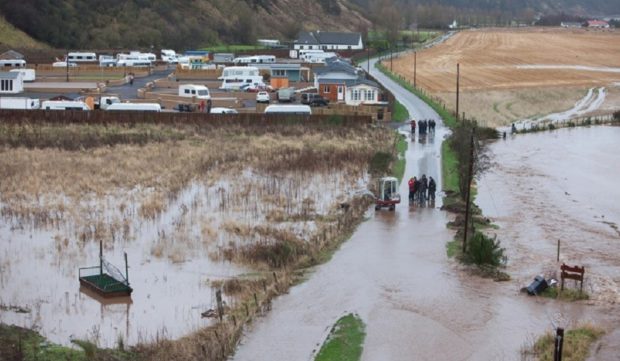The woman tasked with investigating an unauthorised Travellers’ encampment at St Cyrus has asked for answers over ten issues relating to flooding.
The Scottish Government-appointed reporter Allison Coard wants the Scottish Environment Protection Agency (Sepa), Aberdeenshire Council and planning agent Alan Seath to provide further information to help with the preparation of her report and recommendations to Scottish Ministers.
North Esk Park applicants William Docherty and Jim Reid had requested a hearing to settle flooding concerns at the centre of a six-year planning battle, without success.
The reporter will instead make a site visit to North Esk Park on December 20.
To date, in support of the plans, the applicants have provided a flood risk and drainage assessment as well as a flood resilience plan prepared by the Scottish Flood Forum.
They say the document will demonstrate the potential impacts of flooding associated with the proposed developments “fall within acceptable levels so as to allow for planning permission to be granted”.
The North Esk Park site has substantially expanded since the first temporary homes appeared without prior authorisation in September 2013.
The reporter is being asked to submit a report with recommendations to ministers for their consideration.
The application will be scrutinised in view of its potential conflict with national policy on flooding, after Aberdeenshire Council approved retrospective planning applications from the Travelling community for almost 20 touring and permanent pitches on June 26.
This was despite an objection from the Scottish Environment Protection Agency (Sepa).
It was the second time councillors had agreed to approve the site, after a similar application was given the go-ahead in 2016.
The 10 questions include asking for a summary of any relevant changes to address Sepa’s concerns or those of the previous reporter in concluding that the site gives rise to substantial risk to life and property.
All the listed parties will then have 14 days to comment on the information supplied by the other listed parties if they wish to do so.
Following the final round of comments and circulation, the written submissions procedure will be brought to a close.
A previous application, approved by councillors in 2016, was called in by the Scottish Government when Sepa objected.
The agency said the site had flooded in 2002, 2012, 2013 and 2015.
Ministers overturned the permission and Travellers were given until July 31 last year to clear the site.
The council then agreed to extend the deadline by six months before fresh applications were lodged.
Because Sepa has also objected to the new plans, the applications were again referred to Scottish Government ministers.
The matters to which the parties will be asked to respond:
1. Confirmation that part of the site is within the 1:200 year plus flood plain.
2. Clarification of the area of both sites to which this risk applies and an explanation of the nature and consequences of that risk.
3. Differences in flood risk prior to and after land raising, the impact on risk and appropriateness of reliance on this mitigation.
4. Potential impact of land raising on adjacent land.
5. What if any exceptional circumstances would justify land raising.
6. Acceptability of flood risk impact on the access to the site.
7. The adequacy of the flood resilience and action plan.
8. Clarification of the methodology for undertaking hydrological analysis of the River Esk and the consequences of the different technical approaches between Sepa and the applicant.
9. Assessment and risk of a coastal flooding event.
10. A summary of any relevant changes through these current applications and their sufficiency or otherwise to address Sepa’s concerns or those of the previous reporter in concluding that the site gives rise to substantial risk to life and property.










